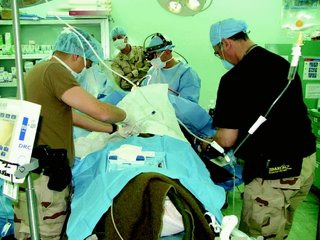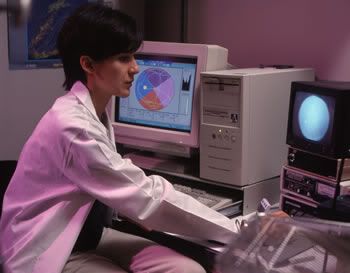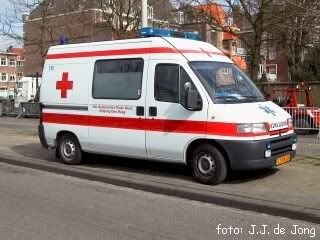Neurologists in war: Personal perspective
It didn’t seem real until that nighttime helicopter ride. Lights out, machine guns up, and skimming a mere 50 feet over rooftops at over 150 miles per hour. We were en route to the Combat Support Hospital (CSH) located in Baghdad at the frontline of the Global War on Terror. That is when we came to the full realization that we were joining a long line of neurologists going to war with U.S. forces that stretches back at least to Dr. S. Weir Mitchell, who joined the Union Army during the Civil War. In 2005, it was our turn—one of us in the spring and the other in the fall.

Figure 1. The Neuro team in full battle rattle outside the 86th CSH front entrance in Baghdad, Iraq. (From left to right) COL Geoffrey Ling (neurology and critical care) and COL James Ecklund (neurosurgery).
Why send neurologists to war? Simply, neurologic disease is found everywhere, including the modern battlefield of Operation Iraqi Freedom. Among severe battle injuries, head wounds lead. Even among non–battle-related injuries, neurologic causes are common. Headache, seizure, neuropathy, alteration in mental status, and back pain are as frequent in this community as elsewhere.
It began with a phone call—one that put the rest of our lives on hold. With a couple weeks’ notice, we had barely enough time to find clinical coverage, cancel appointments, and hug our families. Our odyssey officially began at the Continental United States Replacement Center or CRC. Here, we were issued three duffle bags full of equipment. Notably, we each got weapons—typically a 9-mm pistol and/or M-16 plus full “battle rattle”: a helmet, armored vest with ceramic plates, holster, and the other accoutrements of the properly attired military physician. Next all doctors were re-educated on being soldiers: how to protect a convoy, don a gas mask, and establish a defensive perimeter. Some courses were quite good. We learned about local Arabic customs, indigenous fauna to avoid, and “don’t drink the water.” Some lessons, such as basic first aid, were less useful to us. We were all required to qualify with our weapons. This entailed proceeding down a path and shooting at (and hitting) pop-up targets. After medical and dental screenings, checking our life insurance policies, and verifying our wills, we were shipped off to Kuwait. There, we were separated into common final destination groups. Ours was off to Baghdad.
Since returning from deployment duty in Iraq, we have been asked, “What was it like?” Simply put, it was both good and bad. The bad parts seemed relatively minor in the more global view of why we were there—to take care of wounded American soldiers. Although we were not “at the tip of the spear” on patrol with the troops, the CSH was in a war zone. We were reminded daily that this was not home. We were required to carry our weapons at all times, including when on clinical rounds. Whenever we ventured out of the hospital, we had to be in full battle rattle (figure 1).
To the uninitiated newcomer, this may have seemed excessive. That is until the first experience of the boom and ground shaking associated with an explosion. Incoming mortar shells occasionally disrupted clinical rounds. Even the local outdoor market where we shopped was destroyed by a suicide bomber. At such times, no one hesitated to don battle rattle. The equipment was hot and heavy, but at the same time, remarkably effective. Without a doubt, this equipment is saving lives. Some unsung heroes of this war are the material scientists who invented it. The soldiers believe in it, and so do we.
Another reminder of the distance from home was the dust. Dust everywhere. Dust not like sand at a beach but rather like talcum powder. It got into everything—laptop computers, clothes, and toothbrushes. Another reminder was the heat. When we first arrived, it was so bright and the heat so intense that we felt like we were on another planet. An air temperature of 125 °F is oppressive, regardless of how dry it is. Being in battle rattle only exacerbated this. We were amazed that our troops are able to perform so efficiently under such severe conditions.
Without a doubt, the toughest part of being deployed was being away from our families. E-mail helped as letters from home were almost real-time. If it were not for missing our families, most of us would gladly have stayed longer.
“Dear Soldier” cards from schoolchildren and goodie packages from well-wishers were sources of comfort. These kindnesses, especially Girl Scout cookies, were shared and deeply appreciated by everyone.
Retrospectively, the bad parts seem insignificant. The best part was the practice of medicine. At the CSH, everything goes except basic medical practice—“taking care of the patient.” No matter what one’s specialty, when at war, we are general physicians first.
The CSH was busy! On a typical day, 15 to 60 trauma patients would come through the emergency department and up to 100 through the clinic. For only 30 physicians, this was an extraordinary patient load. While most of the practice of war medicine was trauma care, there was constant and significant nonsurgical care. The majority of our patients fit the latter category.
The defining sound for military physicians is the sound of an inbound helicopter. Since the Korean War of the early 1950s, dependence on air ambulances has increased. Images conjured by the opening sequences of the television show MASH seemed appropriate to our hospital. We will never forget the “whump whump whump” of helicopter rotor blades that could be heard throughout the hospital. Medics rushed out to the landing pad and offloaded up to eight patients at a time. On a busy day, helicopters were constantly landing or taking off, and it was not unusual to have 10 to 20 critically injured patients come in at a time, many with tourniquets over missing or mangled limbs and actively being resuscitated. At such times, we neurologists acted as general physicians, doing triage, compressing a wound, or starting a central venous line.
For a neurointensivist, i.e., neurologist who practices critical care medicine, work in this type of hospital was an opportunity to use all of his/her critical care and neurology skills. It began in the emergency department, assisting in initial assessment and resuscitation. The emergency medicine physician, who orchestrated the initial clinical care, depended on the active participation of all physicians regardless of specialty. But while everyone helped, it was valuable to have someone who was comfortable managing hemorrhagic shock, ventilatory failure, and invasive procedures including endotracheal intubation. Patients who did not require immediate surgery were taken to the intensive care unit (ICU). Here, care continued, including intracranial pressure monitoring and mechanical ventilator management. For neuro-patients in the ICU, the primary physician was the neurointensivist.
For optimal care of the critically ill neurologic patient, close coordination between neurosurgery and neurology was necessary. A highlight of deployment duty was being able to work in an environment that was so conducive to collegial practice and mutual respect with our neurosurgical colleagues. Their contribution to caring for casualties cannot be understated, and the neurosurgeons we served beside did heroic deeds routinely.
 Figure 2. The Neuro team in action. Working together in a collegial and mutually respectful manner with our colleagues ensured optimal, timely care for patients and was a personal highlight of the deployment.
Figure 2. The Neuro team in action. Working together in a collegial and mutually respectful manner with our colleagues ensured optimal, timely care for patients and was a personal highlight of the deployment.
For example, on one busy evening, six neuro patients were brought in. The most seriously ill had an open head wound with exposed herniating brain. He was taken immediately to the operating room. The other five patients had head wounds to spine injuries. Each required evaluation and treatment; one would also need neurosurgery. While the neurosurgeon was operating, the neurologist managed the other patients. This meant suturing a head laceration, reading the CT scans, and medically resuscitating the others. It also meant going into the OR to confer with our neurosurgical colleague to determine specifically what was and what was not operable. In the end, all did very well.
Beyond the ICU, we also practiced traditional general neurology. Each day, 50 to 100 outpatients came to the CSH. Many were referred to a neurologist by a military unit’s physician or physician’s assistant. Often our important task was to determine who was able to return to duty. A field commander needs adequate numbers of able-bodied troops. Medical decisions as to mission readiness had to be made quickly and decisively.
Patients were referred for neurologic assessment for many disorders. The leading cause was headache: migraine, tension, and even cluster headaches. Serious conditions such as arteriovenous malformations, stroke, or subarachnoid hemorrhage were sometimes discovered. Soldiers who could be treated successfully with simple interventions, such as a triptan, were sent back to duty. Others needed to be evacuated from the war theater.
One particularly vexing condition was postconcussive syndrome. Mild head injury was common, with causes ranging from a simple bump when exiting a motor vehicle to exposure to an explosive blast. Overwhelmingly, such patients had headaches. Other symptoms included impaired concentration, difficulty sleeping, or anxiety; however, headache remained the primary reason for seeing a neurologist. Typically, nonsteroidal anti-inflammatory drugs were used. Failing that, a triptan might be used if there was a migrainous component. If the headache was atypical, an antiepileptic drug such as gabapentin was tried. Impaired concentration was assessed by traditional mental status examination and very simple neurobehavioral testing. If impaired, such patients were hospitalized for bed rest. Treatment success or failure had to be determined quickly, often within a day or two, or else the patient had to be evacuated from theater. Such decisions had major consequences to the soldier’s unit and were thus done with appreciation of the military operational consequences.
Alterations of consciousness were a leading concern. The overriding issue was whether or not the soldier had suffered a seizure and, if so, whether an initial event was a harbinger of epilepsy. EEG, MRI, and even antiepileptic drug levels were not available. Medical decision-making was largely dependent on neurologic examination, history, and CT as these were the only neurodiagnostic tools we had.
Acute changes in mental status presentations ranged from loss of consciousness and loss of awareness, to psychosis. Often, these changes were related to trauma, metabolic or infectious etiologies. Alcohol and drug abuse were relatively rare. Alcohol use, including beer, is forbidden to all U.S. forces. Sometimes, patients needed referral to the psychiatrist.
In the war theater, the practice of neurology is at its most fundamental level. Patient care is all that matters. The usual concerns of regular life—committee meetings, paperwork, traffic jams, a parking space too far from the front door—vanish. Our patients were special to us. The American soldiers we took care of were proud of what they were doing. They were determined and committed. Almost everyone wanted to return to duty.
One particular case was a patient who suffered a fractured spine after being thrown from a vehicle struck by an explosive. When he was told that he was going to be sent home, this young soldier cried and begged us to let him stay. When told he was a hero and had nothing to be ashamed of, he told us that here he was doing something truly important, helping people who are trying to build a free and just nation. His example of nobility was one of many.
So, when asked, “How was it?” We can confidently say it was one of the most rewarding experiences of our lives. We were able to practice our neurology specialty to make a difference both in the war effort and in our individual patients’ lives. We were able to practice general medicine and make contributions that were much greater than in normal, day-to-day practice. But, better still, we had the honor of taking care of the most deserving patients anyone could find anywhere: the American soldier at war defending the principles of freedom, self-rule, and equality that define the United States.




0 Comments:
Post a Comment
<< Home